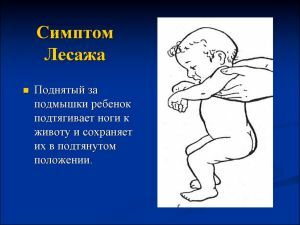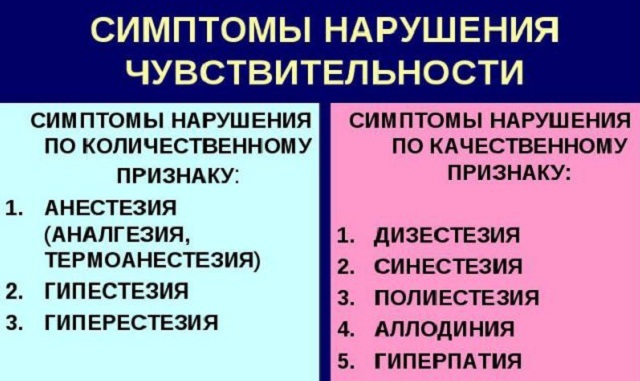 Speaking of reflexes, specialists have in mind some of the body's response actions to the effect of an external stimulus.
Speaking of reflexes, specialists have in mind some of the body's response actions to the effect of an external stimulus.
A classic example is a knee-jerk reflex, in which the patient is asked to put his foot on his leg in such a way that one knee is placed above the other, and then suddenly strikes a little under the patella.
The correct reaction of the organism in this case is the extension of the leg, which helps to maintain balance and posture.
Distortion of the reflex: from increase to decrease
As a deviation from the norm, hyperreflexia( reflex increase) is singled out, at which in the example above the leg will be maximized, or hyporeflexion( reflex reflex), expressed in a weak reaction to an external stimulus, as well as in complete absencesuch.
In both cases, such distortions in the response of the body are evidence of changes in the nervous system. If the reflexes are reduced, then most likely, the integrity and conductivity of the reflex arc is disrupted in one of its three sections - efferent, combining, or afferent.
While their excessiveness signals increased reflex activity from the spinal cord. As a rule, this is a consequence of the pathology of the pyramidal pathways, in which the cortex transmits inhibition to the spinal mechanisms.
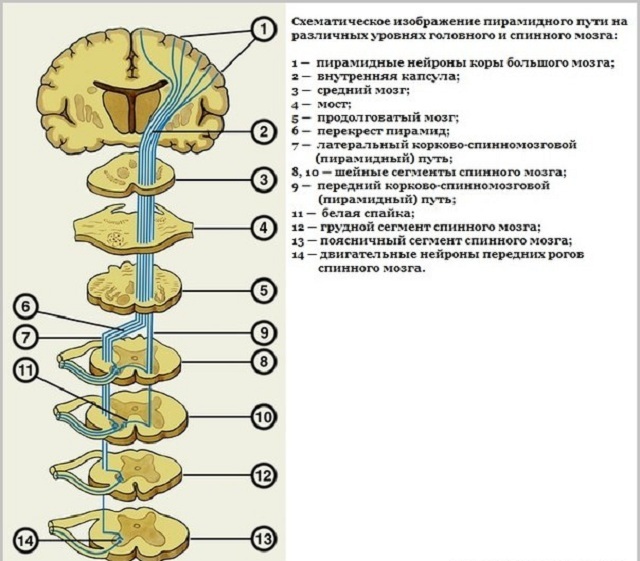
Pyramid path
Clone and its causes
Extreme manifestations of hyperreflexia are expressed in the rhythmic alternation of tendon reflexes, and are called clones. Using this term, most often mean fast jerky contractions of the muscles of the foot or knee cap. In addition, you can observe the clone of the fingers on the legs and hands, the lower jaw, buttocks or forearm. 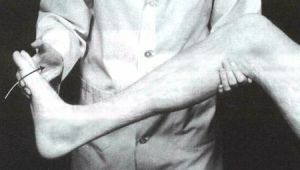
The causes of this syndrome are different. So, if the clone arises spontaneously, then, as a rule, you can talk about epilepsy, or diseases such as a nervous tic or tremor.
Sometimes a clone occurs due to external stimuli, accompanying diseases such as meningitis, encephalitis, stroke, brain tumors, or craniocerebral trauma. By reacting to a single stretching of the tendon, the clone is expressed in the multiple contraction of the parallel muscles, and in this case it is difficult to predict the duration of this process.
In contrast, prolonged stereotyped muscle contractions, characteristic of true clone, along with spasticity of muscles, increased tone, tendon and periosteal reflexes, are symptomatic of a pathological condition such as central paralysis.
 Diagnosis The clone of the patella is characterized by its sharp shift down, while retaining the accepted position even if it is pulled. In order to provoke this altered reflex, the patient is asked to take a horizontal position and straighten his legs.
Diagnosis The clone of the patella is characterized by its sharp shift down, while retaining the accepted position even if it is pulled. In order to provoke this altered reflex, the patient is asked to take a horizontal position and straighten his legs.
After this, the doctor grasps the knee cap with two fingers - thumb and forefinger, moves it down and holds it in that position. The tendon stretches, resulting in the muscles begin to contract involuntarily, and the patella - rhythmically twitch.
To provoke a clone of feet, the patient must also be laid on the couch and with one hand bend his leg in the knee and thigh, and the other - to grab the foot, sharply bend it and unbend it. Stretching, the Achilles tendon will provoke uncontrolled rhythmic movements of the foot, resembling twitchings. 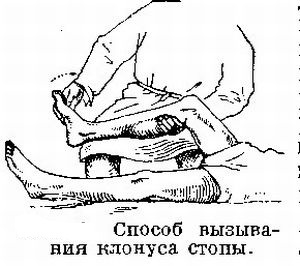
It is worth emphasizing that both of the examples of altered reflexes indicate abnormalities from the nervous system. But nevertheless, one of the most unfavorable situations is the uneven increase in reflexes( the so-called anisoreflexia), in which the left and right halves of the body react to a stimulus with varying degrees of intensity.
Unlike the symmetrical enhancement of reflexes, which does not always mean that this is a sign of brain damage, their unevenness is an alarming symptom. As a rule, this is possible in two cases: the oppression of the reflex on one side, associated with the defeat of the reflex arc in the nerve, the roots or gray matter of the spinal cord, or its activation to the other( which indicates the defeat of the pyramidal pathway).
The clone of the foot in practice looks like this:
Further research and treatment of
It is possible to thoroughly study the changes in reflexes with the help of modern diagnostic methods such as MRI, ultrasound and computed tomography.
Electroencephalography is used to record the electrical impulses of neurons. And in order to assess the electrical potentials of skeletal muscles - electromyography. In addition, a complete picture of the disease will help establish the study of blood and cerebrospinal fluid.
 After the whole complex of diagnostic studies has been carried out, the specialist will prescribe a treatment regimen depending on the characteristics of the underlying disease.
After the whole complex of diagnostic studies has been carried out, the specialist will prescribe a treatment regimen depending on the characteristics of the underlying disease.
Most often, patients with pyramidal and extrapyramidal disorders show drugs that relax the muscles, as well as maintaining normal metabolism in nerve cells.
It should be noted that the treatment of this group of diseases can not do without balneo - and physiotherapy, physiotherapy exercises and acupressure, a positive effect will be seen from the sessions with a psychologist.
The complex approach to the solution of pyramidal and extrapyramidal disorders allows to significantly slow the progression of their pathological manifestations. Nevertheless, there is no need to speak about a favorable prognosis, and maintenance therapy should be constant.
What can be advised by
? In order to prevent a clone, in the most severe cases of paralysis, it is necessary to reject bad habits, careful treatment of infectious diseases, constant measurement of blood pressure and control over it. 
In addition, the state of the nervous system is well influenced by adherence to a healthy lifestyle, expressed in long walks, full-fledged sleep and regular physical education, as well as adherence to proper nutrition and a varied diet.
It should be noted that the nervous system is well fortified with B vitamins, and do not forget about their periodic intake.
So, the clone is the maximum possible reaction of the body to the external effect, expressed in rapid involuntary contractions of the muscles, under certain conditions, characteristic of the knee cups and feet. As a rule, this increase in the reflex is a symptom of a serious pathology of the nervous system, so it is important to identify it as soon as possible, and then start to diagnose and treat the underlying disease.


